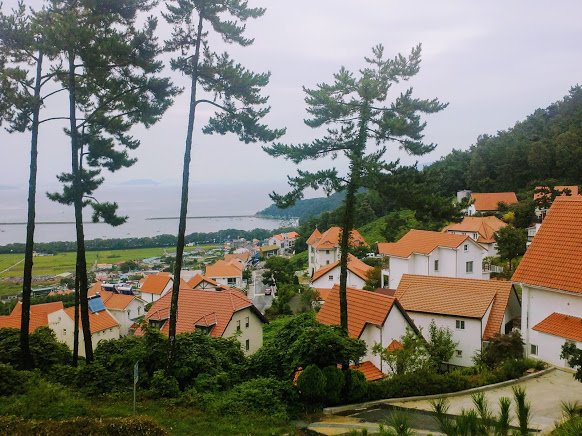German village is one of the three theme named village located in the Island of Namhea Gyeongsangnam - do. The other two are France village and the American village. German village is famous for its unique cultural aura and most visited during weekend and its peak season, the German Village Beer Festival, named after Munich’s own Oktoberfest will be held from October 6th to 8th at the picturesque German Village where authentic German beer and homemade sausage can be enjoyed. It is also open for guest house to anyone who desires to spend the entire visit in the Island. The price ranges from 90,000 won depending on the season.

Finally were here, our main itinerary during our visit in the Island of Namhea. Our Namhea trip was something no one was prepared with. It was a sudden plan during grandma and Immo's visit in Korea who had migrated in America over 30 years ago. My parents in-laws have just settled back in Korea as well, and I am foreigner meaning we were all unfamiliar about our journey. Thanks to this informative map, we we're guided thoroughly towards our entire trip.
As usual, learning a few about the area, as you can see the very informative map it is really quiet interesting.
We just love our whole journey, the advantage of travelling during weekdays, parking lot is all yours. and it is free of charge. Well it is free even weekends I believe.
We are on the best upper part of the parking lot otherwise if it is during busy days you if you would end up in the bottom it is a bit far walk especially when you are travelling with seniors.
Speaking of seniors, If you are travelling with one. Such as theme parks and other tourist destinations, you can always make a request for wheelchairs from the ticketing both. I did not think about this until we've reach day three. Thanks God! Grandma was still fully loaded with energy.
That is the ticketing both where we paid our ticket to looked around for 1,000 won per person. There were five of us but grandma and aboniem are seniors so they were free of charge so we only paid 3,000 won, a bit less $3 dollars.
The village is famous in the Island and indeed was a worth of a far driving adventure. They have variety of western and German food around which looks delicious, but my family were craving for seafood so we passed and saved our bellies for the Namhea's best.
Being here is just like stepping into a real German village, you can feel the mood of it especially when you enter the shop with German citizens attending the store.


The scenery from almost every angle of this place is just amazingly beautiful. Watch the video if you haven't done so to see more of it's beauty. We also came in a perfect weather of early September when summer just had ended it's annoying heat.
From this area, we were approached by a very nice lady who introduced herself as one of the caretaker of the village. She gave us a bit of information about the history of the village. She even walked around with us giving details of such and such.
Houses with red colored roof tiles and white walls are very German style. Most residents are also much accustomed with German life because they lived in Germany for a long time mostly as nurses and miners when Korea economy was struggling in the past history. They are real founders for Korean economical miracle now.
One sample of the Munich not sure if one it was one of what the lady caretaker mentioned from the 3 very famous Palaces by King Ludwig the 2nd since the Bavarian Kingdom Era. Munich was then the capital city of the Kingdom in South Germany named Auf Wiedersehen.
While some are occupied, some serves as vacation house since most of the owners prefer to live in other cities. The history begun in 1960s when many Korean migrated in Germany during the modernization of Korea. The village is now a unique tourism spot related to German culture since 2001.
There is some kind of a botanical garden across the street, But it was past 12 pm and my family are hungry for seafood so the plan was to as eat up then continue the journey but we found the restaurant too far away and found more places to explore. So we are definitely coming back again.
It was indeed a satisfying visit and we headed for a seafood restaurant hunting. Which became another part of adventure around the beautiful coastline of Mijo.























I have never been to Germany but it looks just like the pictures I have seen. Do you know if the people speak German to each other?
ReplyDeleteJeannie@GetMetoTheCountry
The staffs from the stores do as most business operators are Germans. That's what I've noticed.. Most of the owners probably prefer to live in their own hometowns and had it rent out for guest houses..
Delete